Unit 4 Space Exploration Reading and Thinking 课件(共20张)-2025-2026学年人教版(2019)必修第三册
文档属性
| 名称 | Unit 4 Space Exploration Reading and Thinking 课件(共20张)-2025-2026学年人教版(2019)必修第三册 | 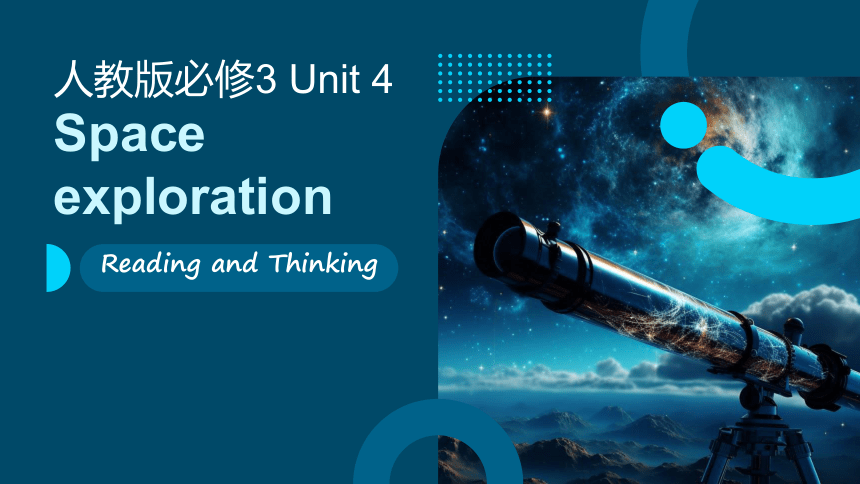 | |
| 格式 | pptx | ||
| 文件大小 | 3.7MB | ||
| 资源类型 | 教案 | ||
| 版本资源 | 人教版(2019) | ||
| 科目 | 英语 | ||
| 更新时间 | 2025-06-17 21:48:03 | ||
图片预览

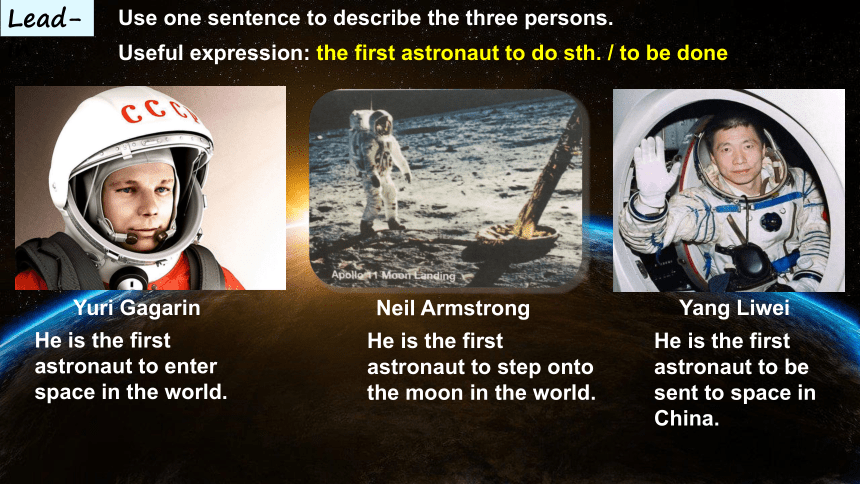
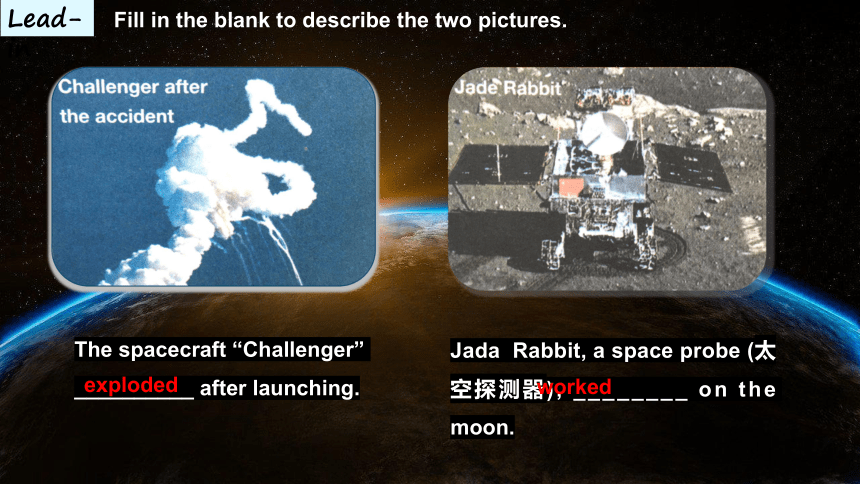
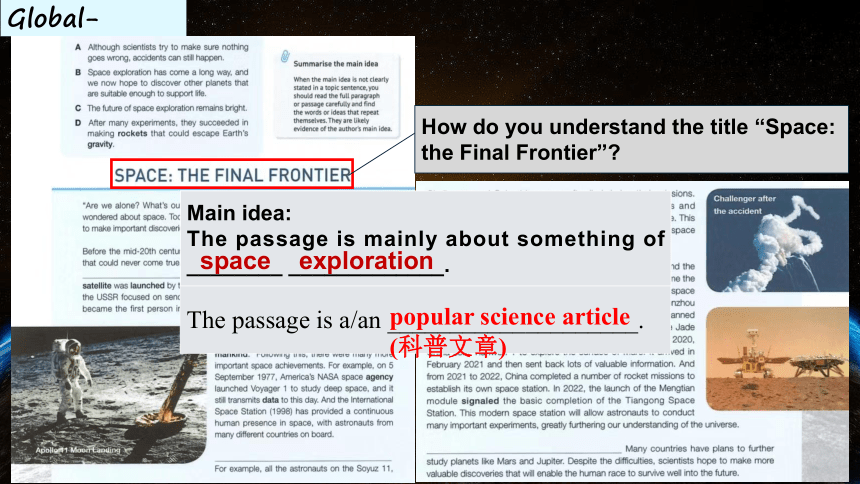

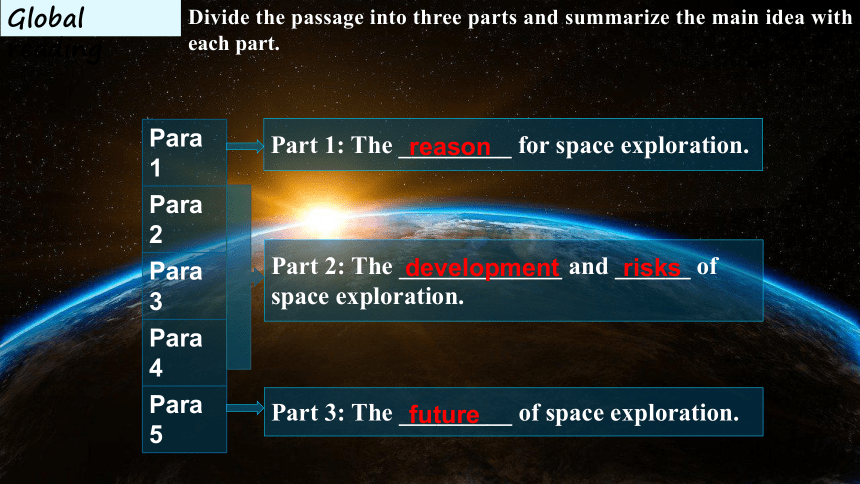
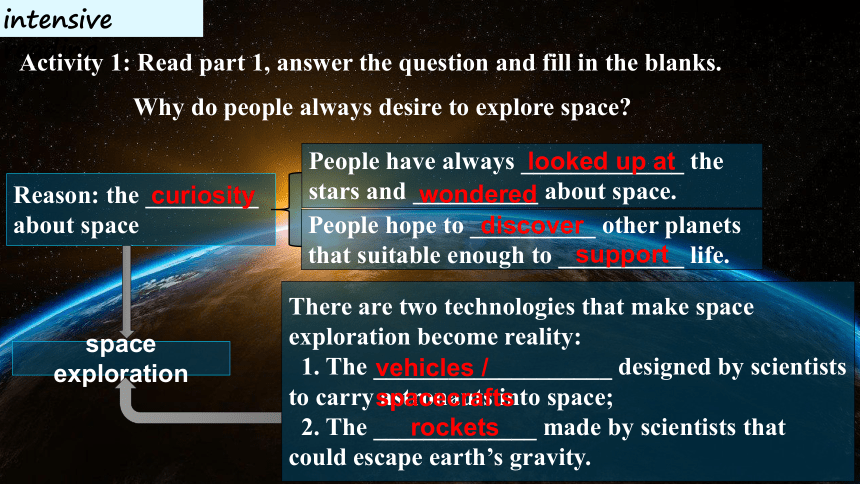
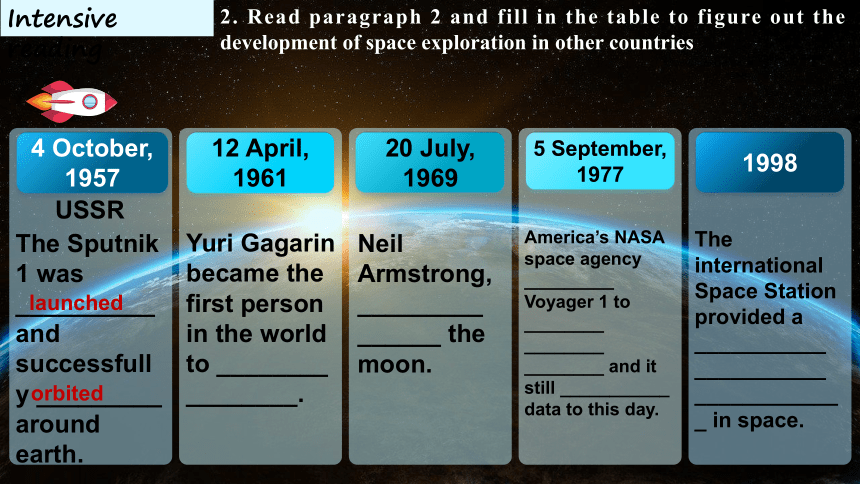
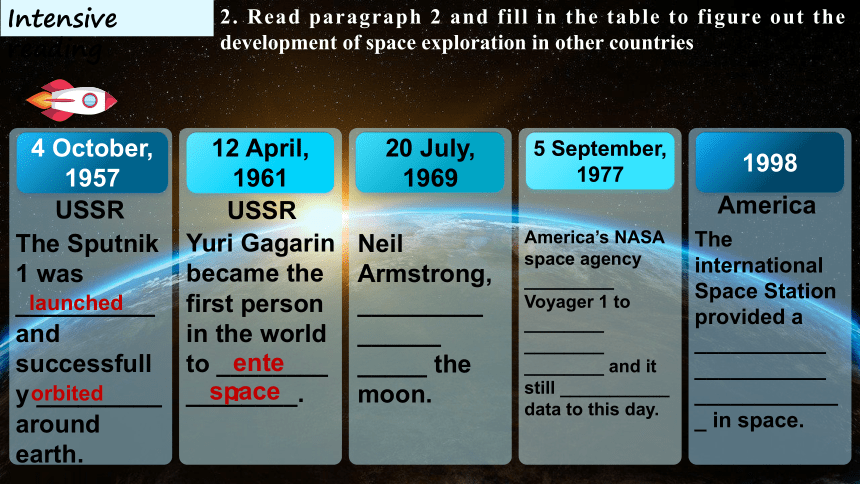
文档简介
(共20张PPT)
人教版必修3 Unit 4
Space exploration
Reading and Thinking
Yang Liwei
Yuri Gagarin
Lead-in
He is the first astronaut to be sent to space in China.
He is the first astronaut to enter space in the world.
Neil Armstrong
He is the first astronaut to step onto the moon in the world.
Use one sentence to describe the three persons.
Useful expression: the first astronaut to do sth. / to be done
The spacecraft “Challenger” __________ after launching.
Jada Rabbit, a space probe (太空探测器), ________ on the moon.
exploded
worked
Lead-in
Fill in the blank to describe the two pictures.
Global-reading
How do you understand the title “Space: the Final Frontier”
Main idea:
The passage is mainly about something of ________ _____________.
space exploration
The passage is a/an ____________________.
popular science article (科普文章)
Several sentences have been removed from it. Choose the correct sentence (A-D) to fill each gap.
B
D
A
C
Global-reading
Part 3: The _________ of space exploration.
Part 2: The _____________ and ______ of space exploration.
Part 1: The _________ for space exploration.
Global reading
Para 1
Para 2
Para 3
Para 4
Para 5
Divide the passage into three parts and summarize the main idea with each part.
reason
development
risks
future
intensive reading
Activity 1: Read part 1, answer the question and fill in the blanks.
Why do people always desire to explore space
Reason: the _________ about space
People have always _____________ the stars and __________ about space.
People hope to __________ other planets that suitable enough to __________ life.
curiosity
looked up at
wondered
discover
support
space exploration
There are two technologies that make space exploration become reality:
1. The ___________________ designed by scientists to carry astronauts into space;
2. The _____________ made by scientists that could escape earth’s gravity.
vehicles / spacecrafts
rockets
Intensive reading
4 October,
1957
1998
20 July,
1969
12 April,
1961
5 September,
1977
The international Space Station provided a ___________ ___________ _____________ in space.
America’s NASA space agency _________ Voyager 1 to ________ ________ ________ and it still ___________ data to this day.
Neil Armstrong, _________ ______ the moon.
Yuri Gagarin became the first person in the world to ________ ________.
The Sputnik 1 was __________ and successfully _________ around earth.
launched
orbited
2. Read paragraph 2 and fill in the table to figure out the development of space exploration in other countries
USSR
Intensive reading
4 October,
1957
1998
20 July,
1969
12 April,
1961
5 September,
1977
The international Space Station provided a ___________ ___________ _____________ in space.
America’s NASA space agency _________ Voyager 1 to ________ ________ ________ and it still ___________ data to this day.
Neil Armstrong, _________ ______ _____ the moon.
Yuri Gagarin became the first person in the world to ________ ________.
The Sputnik 1 was __________ and successfully _________ around earth.
launched
orbited
enter
space
2. Read paragraph 2 and fill in the table to figure out the development of space exploration in other countries
USSR
USSR
America
Intensive reading
4 October,
1957
1998
20 July,
1969
12 April,
1961
5 September,
1977
The international Space Station provided a ___________ ___________ _____________ in space.
America’s NASA space agency _________ Voyager 1 to ________ ________ ________ and it still ___________ data to this day.
Neil Armstrong, _________ ______ the moon.
Yuri Gagarin became the first person in the world to ________ ________.
The Sputnik 1 was __________ and successfully _________ around earth.
launched
orbited
enter
space
stepped
onto
2. Read paragraph 2 and fill in the table to figure out the development of space exploration in other countries
USSR
USSR
America
Intensive reading
4 October,
1957
1998
20 July,
1969
12 April,
1961
5 September,
1977
The international Space Station provided a ___________ ___________ _____________ in space.
America’s NASA space agency _________ Voyager 1 to ________ ________ ________ and it still ___________ data to this day.
Neil Armstrong, _________ ______ the moon.
Yuri Gagarin became the first person in the world to ________ ________.
The Sputnik 1 was __________ and successfully _________ around earth.
launched
orbited
enter
space
stepped
onto
launched
study deep
space
transmits
2. Read paragraph 2 and fill in the table to figure out the development of space exploration in other countries
USSR
USSR
America
America
Intensive reading
4 October,
1957
1998
20 July,
1969
12 April,
1961
5 September,
1977
The international Space Station provided a ___________ ___________ _____________ in space.
America’s NASA space agency _________ Voyager 1 to ________ ________ ________ and it still ___________ data to this day.
Neil Armstrong, _________ ______ the moon.
Yuri Gagarin became the first person in the world to ________ ________.
The Sputnik 1 was __________ and successfully _________ around earth.
launched
orbited
enter
space
stepped
onto
launched
study deep
space
transmits
continuous
human
presence
2. Read paragraph 2 and fill in the table to figure out the development of space exploration in other countries
USSR
USSR
America
America
America
3. Read paragraph 4 and comprehend the development of space exploration in China.
Time Vehicle/Spacecraft Event
2003 China became the third country to _______________ _________ humans (Yang Liwei) into space.
Then (_______)
Complete a ________ ________ ________.
Then (_______)
Complete the _______ ________ ___________.
Followed by (_______)
Be sent to the moon to _________ ______ ________.
23 July, 2020
Explore the ________ _____ _______.
From 2021 to 2022
Establish its ______ ________ _________.
2022 Signal the _______ ___________ of the Tiangong Space Station.
2005
2008
2013
The Shenzhou 5 spacecraft
The Shenzhou 6 spacecraft
The Shenzhou 7 spacecraft
Jade Rabbit
Tianwen 1
A number of rockets
The Mengtian module
independently
sent
second manned orbit
first Chinese spacewalk
study its surface
surface of Mars
own space station
basic completion
Intensive reading
Intensive reading
4. Discussion: What do you think these countries can obtain from their missions of space exploration
The Sputnik 1 was launched and successfully orbited around earth.
Yuri Gagarin became the first person in the world to enter space.
Neil Armstrong stepped on to the moon.
America’s NASA space agency launched Voyager 1 to study deep space and it still transmits data to this day.
The international Space Station provided a continuous human presence in space.
China became the third country to independently sent humans (Yang Liwei) into space.
Complete a second manned orbit
Complete the first Chinese spacewalk
Be sent to the moon to study its surface
Explore the surface of Mars
Establish its own space station
Signal the basic completion of the Tiangong Space Station
1. innovative devices and technologies;
3. special research _____ and _________;
5. a _____ perspective (角度) to study space;
4. ___________ with scientists from other countries;
samples
data
cooperation
new
2. ___________ astronauts to explore space;
experienced
Activity 3: Read paragraph 3 and make sense of the risks of space exploration.
space exploration
development
huge risks
1. What kinds of accidents happened
All the astronauts on the Soyuz 11, Challenger, and Columbia spacecrafts died during their mission.
2. What was the attitude of scientists to these accidents Why
They were positive or optimistic. They were still enthusiasm about space exploration, and would never give up, because they believe in the importance of carrying on space exploration.
Coexist with each other
Intensive reading
Intensive reading
Activity 4: Read part 3 and answer the questions.
What is author’s attitude to the future of space exploration
Why
Reasons for bright future
Many countries have plans to further study more planets.
Scientists hope to make more valuable discoveries to enable the human race to survive well into the future.
The author thinks the future of space exploration remains bright.
Summarize the importance of carrying on space exploration.
Summary
Carrying on space exploration
1. contribute to many new inventions of devices or facilities;
2. inspire technological innovation;
3. unlock secrets of the universe, broadening our scientific horizons;
4. help gain scarce resources (稀缺资源) from other planets;
5. promote the development in other fields of science;
6. encourage global cooperation.
1. discover other planets that are suitable to support life;
2. improve products we use every day;
3. facilitate the development of medical and healthcare industries;
4. get young people interested in space and cultivate high-tech talents;
5. create scientific and technical jobs;
6. help us further understand our planet and protect it better.
For scientific fields
For man’s life
Look back at the title “Space: The Final Frontier”, what’s your understanding of it Share your ideas with the whole class.
I don’t think the space is the final field of exploration because on the earth there are still more places to be explored by people, such as the original forests, the remoted mountainous areas, the deep ocean, and the polar regions. There are so many unknown places, and the space is just one of them.
Reading and Thinking
Writing: Space exploration not only benefits our society but also has some risks. Is it worthwhile carrying on space exploration Please write down your ideas according to what we learn. (At least 100 words).
Homework
Thank You
人教版必修3 Unit 4
Space exploration
Reading and Thinking
Yang Liwei
Yuri Gagarin
Lead-in
He is the first astronaut to be sent to space in China.
He is the first astronaut to enter space in the world.
Neil Armstrong
He is the first astronaut to step onto the moon in the world.
Use one sentence to describe the three persons.
Useful expression: the first astronaut to do sth. / to be done
The spacecraft “Challenger” __________ after launching.
Jada Rabbit, a space probe (太空探测器), ________ on the moon.
exploded
worked
Lead-in
Fill in the blank to describe the two pictures.
Global-reading
How do you understand the title “Space: the Final Frontier”
Main idea:
The passage is mainly about something of ________ _____________.
space exploration
The passage is a/an ____________________.
popular science article (科普文章)
Several sentences have been removed from it. Choose the correct sentence (A-D) to fill each gap.
B
D
A
C
Global-reading
Part 3: The _________ of space exploration.
Part 2: The _____________ and ______ of space exploration.
Part 1: The _________ for space exploration.
Global reading
Para 1
Para 2
Para 3
Para 4
Para 5
Divide the passage into three parts and summarize the main idea with each part.
reason
development
risks
future
intensive reading
Activity 1: Read part 1, answer the question and fill in the blanks.
Why do people always desire to explore space
Reason: the _________ about space
People have always _____________ the stars and __________ about space.
People hope to __________ other planets that suitable enough to __________ life.
curiosity
looked up at
wondered
discover
support
space exploration
There are two technologies that make space exploration become reality:
1. The ___________________ designed by scientists to carry astronauts into space;
2. The _____________ made by scientists that could escape earth’s gravity.
vehicles / spacecrafts
rockets
Intensive reading
4 October,
1957
1998
20 July,
1969
12 April,
1961
5 September,
1977
The international Space Station provided a ___________ ___________ _____________ in space.
America’s NASA space agency _________ Voyager 1 to ________ ________ ________ and it still ___________ data to this day.
Neil Armstrong, _________ ______ the moon.
Yuri Gagarin became the first person in the world to ________ ________.
The Sputnik 1 was __________ and successfully _________ around earth.
launched
orbited
2. Read paragraph 2 and fill in the table to figure out the development of space exploration in other countries
USSR
Intensive reading
4 October,
1957
1998
20 July,
1969
12 April,
1961
5 September,
1977
The international Space Station provided a ___________ ___________ _____________ in space.
America’s NASA space agency _________ Voyager 1 to ________ ________ ________ and it still ___________ data to this day.
Neil Armstrong, _________ ______ _____ the moon.
Yuri Gagarin became the first person in the world to ________ ________.
The Sputnik 1 was __________ and successfully _________ around earth.
launched
orbited
enter
space
2. Read paragraph 2 and fill in the table to figure out the development of space exploration in other countries
USSR
USSR
America
Intensive reading
4 October,
1957
1998
20 July,
1969
12 April,
1961
5 September,
1977
The international Space Station provided a ___________ ___________ _____________ in space.
America’s NASA space agency _________ Voyager 1 to ________ ________ ________ and it still ___________ data to this day.
Neil Armstrong, _________ ______ the moon.
Yuri Gagarin became the first person in the world to ________ ________.
The Sputnik 1 was __________ and successfully _________ around earth.
launched
orbited
enter
space
stepped
onto
2. Read paragraph 2 and fill in the table to figure out the development of space exploration in other countries
USSR
USSR
America
Intensive reading
4 October,
1957
1998
20 July,
1969
12 April,
1961
5 September,
1977
The international Space Station provided a ___________ ___________ _____________ in space.
America’s NASA space agency _________ Voyager 1 to ________ ________ ________ and it still ___________ data to this day.
Neil Armstrong, _________ ______ the moon.
Yuri Gagarin became the first person in the world to ________ ________.
The Sputnik 1 was __________ and successfully _________ around earth.
launched
orbited
enter
space
stepped
onto
launched
study deep
space
transmits
2. Read paragraph 2 and fill in the table to figure out the development of space exploration in other countries
USSR
USSR
America
America
Intensive reading
4 October,
1957
1998
20 July,
1969
12 April,
1961
5 September,
1977
The international Space Station provided a ___________ ___________ _____________ in space.
America’s NASA space agency _________ Voyager 1 to ________ ________ ________ and it still ___________ data to this day.
Neil Armstrong, _________ ______ the moon.
Yuri Gagarin became the first person in the world to ________ ________.
The Sputnik 1 was __________ and successfully _________ around earth.
launched
orbited
enter
space
stepped
onto
launched
study deep
space
transmits
continuous
human
presence
2. Read paragraph 2 and fill in the table to figure out the development of space exploration in other countries
USSR
USSR
America
America
America
3. Read paragraph 4 and comprehend the development of space exploration in China.
Time Vehicle/Spacecraft Event
2003 China became the third country to _______________ _________ humans (Yang Liwei) into space.
Then (_______)
Complete a ________ ________ ________.
Then (_______)
Complete the _______ ________ ___________.
Followed by (_______)
Be sent to the moon to _________ ______ ________.
23 July, 2020
Explore the ________ _____ _______.
From 2021 to 2022
Establish its ______ ________ _________.
2022 Signal the _______ ___________ of the Tiangong Space Station.
2005
2008
2013
The Shenzhou 5 spacecraft
The Shenzhou 6 spacecraft
The Shenzhou 7 spacecraft
Jade Rabbit
Tianwen 1
A number of rockets
The Mengtian module
independently
sent
second manned orbit
first Chinese spacewalk
study its surface
surface of Mars
own space station
basic completion
Intensive reading
Intensive reading
4. Discussion: What do you think these countries can obtain from their missions of space exploration
The Sputnik 1 was launched and successfully orbited around earth.
Yuri Gagarin became the first person in the world to enter space.
Neil Armstrong stepped on to the moon.
America’s NASA space agency launched Voyager 1 to study deep space and it still transmits data to this day.
The international Space Station provided a continuous human presence in space.
China became the third country to independently sent humans (Yang Liwei) into space.
Complete a second manned orbit
Complete the first Chinese spacewalk
Be sent to the moon to study its surface
Explore the surface of Mars
Establish its own space station
Signal the basic completion of the Tiangong Space Station
1. innovative devices and technologies;
3. special research _____ and _________;
5. a _____ perspective (角度) to study space;
4. ___________ with scientists from other countries;
samples
data
cooperation
new
2. ___________ astronauts to explore space;
experienced
Activity 3: Read paragraph 3 and make sense of the risks of space exploration.
space exploration
development
huge risks
1. What kinds of accidents happened
All the astronauts on the Soyuz 11, Challenger, and Columbia spacecrafts died during their mission.
2. What was the attitude of scientists to these accidents Why
They were positive or optimistic. They were still enthusiasm about space exploration, and would never give up, because they believe in the importance of carrying on space exploration.
Coexist with each other
Intensive reading
Intensive reading
Activity 4: Read part 3 and answer the questions.
What is author’s attitude to the future of space exploration
Why
Reasons for bright future
Many countries have plans to further study more planets.
Scientists hope to make more valuable discoveries to enable the human race to survive well into the future.
The author thinks the future of space exploration remains bright.
Summarize the importance of carrying on space exploration.
Summary
Carrying on space exploration
1. contribute to many new inventions of devices or facilities;
2. inspire technological innovation;
3. unlock secrets of the universe, broadening our scientific horizons;
4. help gain scarce resources (稀缺资源) from other planets;
5. promote the development in other fields of science;
6. encourage global cooperation.
1. discover other planets that are suitable to support life;
2. improve products we use every day;
3. facilitate the development of medical and healthcare industries;
4. get young people interested in space and cultivate high-tech talents;
5. create scientific and technical jobs;
6. help us further understand our planet and protect it better.
For scientific fields
For man’s life
Look back at the title “Space: The Final Frontier”, what’s your understanding of it Share your ideas with the whole class.
I don’t think the space is the final field of exploration because on the earth there are still more places to be explored by people, such as the original forests, the remoted mountainous areas, the deep ocean, and the polar regions. There are so many unknown places, and the space is just one of them.
Reading and Thinking
Writing: Space exploration not only benefits our society but also has some risks. Is it worthwhile carrying on space exploration Please write down your ideas according to what we learn. (At least 100 words).
Homework
Thank You
